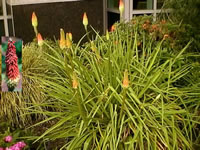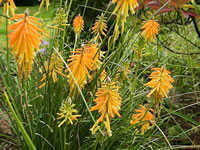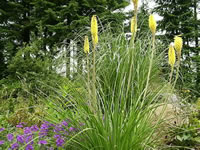How to Grow and Care for a Torch Lily
The Red Hot Poker Plant
Kniphofia uvaria
           
The stately flowers of the Torch Lily provide a dramatic display,
when grown in a space where the entire plant is visible.
Make this planting space directly in front of an evergreen background,
or as a 'stand alone' specimen, and it is sure to turn heads.
Red Hot Pokers are one of the favorite flowers for hummingbirds.
|

|
Kniphofia uvaria is commonly known as a Red Hot Poker, Torch Lily or sometimes a Tritoma
Depending on the variety, the flame colored flower spikes will reach 2-5 feet in height.
The flower's coloring may range from ivory and orange to coral red.
If you have sufficient space, you can select varieties to provide bloom during
every month from May through October!
Growing and Planting Requirements for Torch Lilies
Red Hot Pokers are hardy in USDA zones 5-10.
They must be grown in full sun.
Provide adequate spacing for these plants which may spread up to three feet over time.
Good drainage is essential to prevent crown rot,
otherwise these plants are tolerant of most soil types.
Torch Lilies will survive periods of drought but they will grow much better
if they are given abundant water during hot weather.
|
|
|
Tritomas should be planted in the spring or in the fall months
Add compost and a small amount of peat moss to 'lighten' the soil, and plant this perennial
at the same level at which it was previously growing
NEVER plant Torch Lilies with their crown deeper than three inches.
Tritoma Growing Tips
The soil pH for growing Kniphofias should be near neutral (6.0-6.5)
Torch lilies are not always reliably hardy
so provide winter protection by applying a heavy mulch.
The foliage is evergreen but it tends to take a beating in the winter months,
so it may be helpful to tie foliage together in the fall to prevent water
entering the crown of the plant.
Another option is to cut the foliage off at the base in late fall.
Dead or damaged foliage should be cut off in the spring,
if it was not cut previously.
Fading flower spikes should be removed promptly, to encourage more bloom.
Propagating Red Hot Poker Plants
|
|
Torch Lilies can be propagated by division or they can be grown from seed.
Division should be done in the spring or late fall
After dividing, the blooming of your Tritoma may be reduced for the next one to three years.
Each division can be potted up, and held in a cold frame until new growth is established,
or transplanted directly to a new location in your garden.
Seeds can be sown indoors at any time.
Tritoma seeds need 6 weeks of moist chilling in the refrigerator prior to planting.
After sowing the seeds, lightly cover them with fine soil, then keep them at 70-75° F.
Germination normally occurs in about 20 days, but may take up to 3 months for certain cultivars.
Characteristics of Different Torch Lily Plants
| Variety of Tritoma |
Height |
Colors |
Flowering time |
| Earliest of All |
18-24" |
orange, red, yellow |
early summer |
| Alcazar |
36-48" |
bright red |
early summer |
| Springtime |
36-48" |
coral, yellow |
early summer |
| Gold Mine |
36" |
amber |
mid-summer |
| Little Maid |
18-24" |
yellow, cream |
mid-summer |
| Royal Standard |
36-48" |
scarlet, yellow |
mid-summer |
| Shining Scepter |
36" |
tangerine |
mid-summer |
| Rosea Superba |
30-36" |
bright red |
mid-summer |
| Royal Castle |
24-36" |
orange, yellow |
mid-summer |
| Pfitzeri |
36" |
orange, red |
late summer |
| Galpinii |
36" |
orange |
late summer |
Red Hot Poker Plants
Kniphofia uvaria
 |
 |
 |
|
|
|
Search The Garden Helper:



